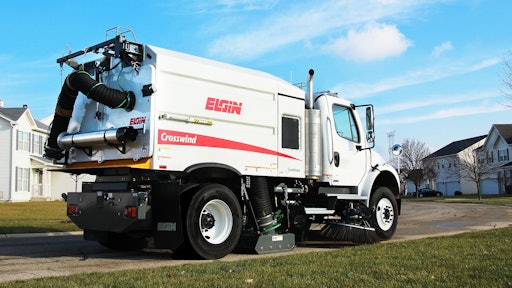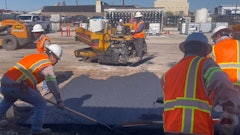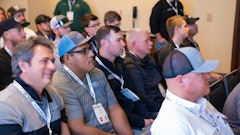
When it comes to efficiently cleaning large flat, paved areas such as streets, parking lots and airport runways, sweeper contractors often turn to regenerative air sweepers. Regenerative sweepers offer simplicity of operation, versatility, flexibility, and productivity.
Regenerative sweepers feature a full-width pick-up head and fuel-efficient drive systems. Large debris hoppers and water tanks provide extended productivity and require fewer stops for dumping, re-watering, and fueling. Routine inspections and simple adjustments are required to keep a sweeper on the road sweeping efficiently and out of the garage.
Water tank
Use of water during sweeping is a vital part of the life and longevity of any regenerative air sweepers. The addition of water during sweeping acts as a lubricant so the debris stream is less abrasive to wear items.
Impellers may be worn prematurely by “carryover” – debris that remains in the airstream. Water is also added to the debris stream to suppress dust by adding weight to the debris. The heavier debris will fall out of the airstream more completely in the hopper. Operators should not continually operate the sweeper without refilling the water tank or checking daily to see if the spray nozzles are functioning.
Unlike pure vacuum sweepers, regenerative air sweepers do not vent or exhaust the air stream into the atmosphere. High volume airflow from the impeller fan is sent to the pick-up head, where it is applied to lift debris from the sweeping surface. Unlike a pure vacuum sweeper, the pick-up head contains both vacuum and regenerative airflow. Dust, dirt and debris containment is vital to the function of the regenerative air sweeper.
Standard configuration
While there are several regenerative air sweeper configurations, the “standard” configuration is used primarily for municipal sweeping applications on streets, parking lots and some alleys. Adjusting the pressure slot and the balance or suspension of the pick-up head will enhance this regenerative air sweeper configuration’s ability to capture and contain dust, dirt and debris.
Checking the pressure slot is the first step. To ensure the pressure slot opening has sufficient clearance from the sweeping surface, the proper measurement from the lowest point of the pressure slot opening to the bottom of the dirt shoe skid should be 1-inch to 1 ½-inch. Depending on the surface being swept, the pressure slot opening may need to be raised or lowered. For instance, a smooth runway requires very low-pressure slot openings, while rough roads with obstructions like raised manhole covers or crowned surfaces may require much higher-pressure slot openings.
Pick-up head suspension
With the engine at idle, the pickup head suspension can be adjusted. Lowering the pick-up head into its operating position and pulling forward several feet will allow any curtains to fold back, enabling the pick-up head to drag into its normal operating position. At this point, the pick-up head’s dirt shoes should be floating about ½ inch off the sweeping surface. This suspension is accomplished by four to eight springs distributed around the pick-up head at each corner. The pick-up head’s configuration - standard head, runway head (airport applications) or equipped with a center broom - will determine the number of springs.
Raising the RPM to normal sweep speed allows the suspension to be inspected further. When the air system is active, this slight float will limit dirt shoe wear as the pick-up head contacts the sweeping surface. Normally, the pick-up head only has contact when the vacuum system is at sweeping RPMs or speeds. The corner springs support the weight of the pick-up head, allowing it to “float” on the road surface. Pulling forward with the RPM at sweep speed should allow the pick-up head to contact the surface without causing marks from the dirt shoes.
Balancing a pick-up head can be difficult if the pressure side is filled with caked-on dirt, which adds weight to the pick-up head. The pick-up head should be removed periodically for thorough inspection and cleaning, including cleaning of the pick-up head curtains. Once the pick-up head is out from under the sweeper, it should be turned over to check the condition of the curtains.
Curtains
Curtains are vital to the sweeper’s ability to seal the pick-up head to the sweeping surface, ensuring the debris under the head will remain there to be conveyed to the hopper. Any rips, tears, holes, missing sections or deformations in the curtains will cause the blast air from a pressure slot to blow material out from under the head, creating a dust cloud as the sweeper travels down the road sweeping. Damaged curtains should be replaced. Any carryover deposits from the air blast portion of the pick-up head should be thoroughly cleaned. Deposits or pieces of carryover debris can build up and disrupt the pressure slot airflow, reducing sweeping performance.
Air flow
The pick-up head is built in two pieces. One side receives the pressurized air flow from an impeller. This “pressurized” air flow must be metered and directed to create the optimum discharge into the “vacuum” side of the pick-up head to dislodge stubborn debris that has adhered to the sweeping surface. The discharge is commonly controlled and metered through a “pressure slot” or “air knife” with specific dimensions to best use this air flow, stream or blast.
Always check the sweeper manufacturer’s specifications regarding adjustments. Factory specifications provide general setup for “most” applications. If the pick-up head isn’t performing properly, the pressure slot openings can be manipulated as a trial-and-error process to maximize air flow. If this step does not enhance the performance of the head, all adjustments should be returned to factory settings (normally a 1/2-inch pressure slot opening). Larger openings allow greater air volume with slower air movement, while smaller openings allow faster air movement with reduced air volume.
Vacuum enhancer
Another component common to regenerative air sweepers is a “vacuum enhancer” device – usually a small door or flap in the pressure tube that will divert some air or let it escape for specific applications, creating more vacuum to pick up sand, leaves or other fine debris. Diverting the incoming air from the pick-up head leaves only vacuum under the head, which enhances the vacuum for fine or light debris applications. Most municipalities are faced with leaf-sweeping applications late in the year. In this case, removing a forward curtain (the heavier of the two) and using the vacuum enhancer to capture leaves more effectively without blowing them out from under the pick-up head can be very helpful. It also reduces the chance to “plow” the leaves in front of the head.
Drive system
The sweeper configuration includes an auxiliary engine, drive pulley, drive belt and airstream generating impeller. Neglecting the auxiliary engine will lead to expensive repairs. Inspection and service intervals are published by each engine manufacturer. The auxiliary engine should be serviced in accordance with the engine manufacturer’s recommendations.
Tensioning the drive belt extends the life of the belt. There are three common methods for belt tensioning: the tensioner and torque method, the deflection versus pounds to deflect method, or the frequency method. Regardless of the method used, proper belt tension will ensure that the vacuum system meets the manufacturer’s standards. Slipping belts become glazed and must be completely replaced. Regular inspection and service will significantly reduce belt replacement costs.
Pulley
Pulley alignment is also imperative for long belt life. The impeller pulley, tensioner pulley, and engine pulley must be in line to maintain low belt temperature. When adjusting belt tension or replacing the belt, pulley alignment should also be verified.
Impeller
Regular impeller inspections will ensure long life and prevent any significant equipment failures. An inspection is required any time a vibration is noted during sweeping operations. Debris in the impeller can cause vibration. For impeller inspections, access doors or plates should be removed to rotate the impeller (refer to the safety section in the operator and service manuals). When opening the impeller housing, neither the auxiliary engine nor the vacuum system should be engaged. Any piece of equipment that may put someone in harm’s way while performing inspection should be locked out or tagged out. During inspection, look for erosions of the end plate and vanes, blades worn to knife edges and accumulated debris.
Debris in the impeller housing – known as carryover – will cause impeller wear. Minimizing carryover will result in longer impeller life. The sweeper operator should keep the engine running only at the speed needed to pick up debris while sweeping. Running the engine at higher RPM than needed will cause debris to carry over and will result in unnecessary wear on the impeller.
Housing
If the housing has a liner of any kind, the liner should be firmly attached or glued into the housing. If the liner is heavily damaged, the outer diameter of the housing should be inspected for damage from any debris that may be thrown out against the housing. A damaged or perforated housing should be replaced so that it can properly hold a liner afterwards.
Bearings
Bearings used to support the impeller must be serviced with a high-temperature, extreme-pressure grease like Shell Gadus NLGI Grade 2 lubricant. Follow the manufacturer’s instructions regarding how often and how much grease should be used to avoid overheating or failure of bearings.
Operation and service manuals
Every sweeper manufacturer publishes service intervals, preventative maintenance tips and other helpful guidelines in their operations and service manuals. These guidelines must be closely followed to keep the sweeper on the road and out of the service shop. The time invested in studying these manuals can deliver significant payback to the owner in terms of getting more work done and running a safer, more efficient operation.
Conclusion
As with any type of sweeper, lack of maintenance and neglect are very harmful to the machine’s overall performance. Educating operators and service technicians on proper operating and maintenance habits will make all the difference when it comes to extending the life of a regenerative air vacuum sweeper and minimizing the overall cost of ownership.
Steve Dunning is technical training instructor, Elgin Sweeper, whose products are sold and serviced through a network of more than 100 dealer locations worldwide. Elgin Sweeper is a subsidiary of Federal Signal Corp.'s Environmental Solutions Group. For more information visit www.elginsweeper.com.



























